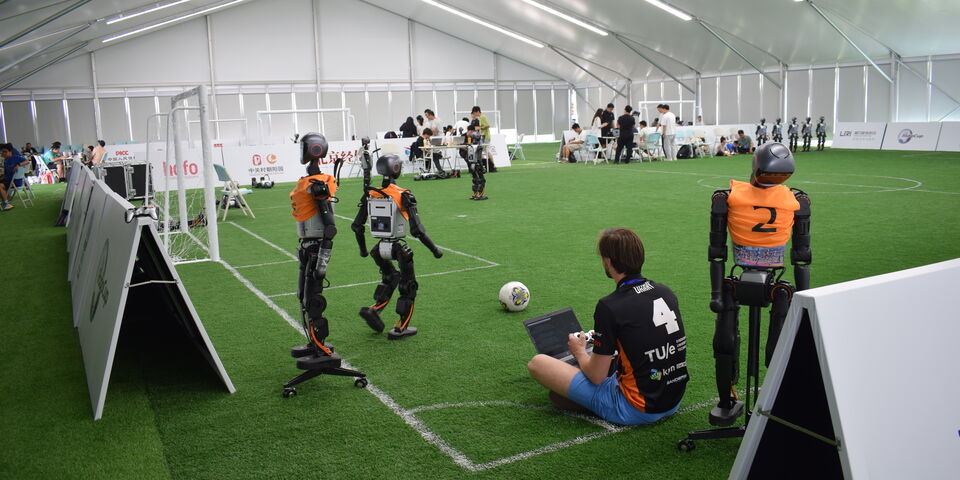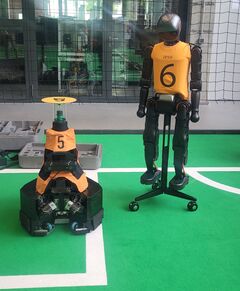Tech United ends in Humanoid Robot Games prelims
Eight-time robot soccer world champion Tech United from TU/e has been eliminated in the preliminary rounds of the first-ever World Humanoid Robot Games (WHRG) in Beijing this week. After two losses and a draw, the team will not compete in the tournament this weekend. Still, they look back positively on the experience gained and hope to reach the finals within the next three years.
The World Humanoid Robot Games is the first global competition in which humanoids—human-like robots that walk on two legs—compete in five-on-five matches. “Not to be confused with RoboCup, where Tech United participates every year with wheeled MSL robots,” emphasizes team member Danny Hameeteman. During the inaugural edition in China, the team was able to use humanoids that walk and kick the ball, just like human players.
From wheels to legs
It was the first competition of its kind, and for many of the nearly thirty participating teams, it was a completely new experience. “And it was also the first time we played five-on-five,” Hameeteman explains. “Normally, it’s two-on-two or three-on-three, so this was quite different.”
Although Tech United was knocked out in the preliminaries, the team sees their participation as an important first step in the transition to humanoid soccer. “We didn’t expect to reach the finals, because we’ve only just started working with this.” The team only purchased their first humanoid in May, which, incidentally, does not yet have a name. “We’re currently running a contest to come up with a fun one.”
Tech United currently owns just one humanoid, but they were still able to play matches in China thanks to robots provided on-site for each team. “It was a fantastic opportunity to test with a full squad of five robots, so we consider it a successful event,” says Hameeteman.
Software
Although all teams in China played with the same robots, performance still varied greatly. That’s because the success of a soccer-playing humanoid depends largely on the software that controls it, Hameeteman points out. “Each robot comes with a basic software package that lets it walk and recognize the ball. You can then fine-tune it to improve things like vision and positioning,” he explains. “Right now, a robot might still wander off the field in the middle of a match, which obviously isn’t ideal.”
“In recent months, we’ve been busy adapting the software we use for MSL robots to work with humanoids,” says Hameeteman. That comes with its own set of challenges. “A robot on wheels is stable, but a humanoid can easily fall over—and of course, you want to prevent that,” he explains. “Fortunately, thanks to a special algorithm, it can stand back up on its own,” he adds with a laugh. Since the humanoids’ design closely mimics human anatomy, the team works with real human player data. “We’d like to invite a soccer player at some point to track their movements and apply that knowledge to our software.”
Perfect timing
The transition from wheeled robots to humanoids aligns well with RoboCup’s plans to phase out the MSL competition over the next two years. “The timing for the switch is perfect for us,” says Hameeteman. Tech United’s ambitions are high: to reach the WHRG finals within three years, and ultimately—by around 2050—win against professional human soccer players with humanoids. What is the team’s biggest strength compared to others? “We focus on making sure our robots can anticipate and work together, just like a real team,” says Hameeteman. “But to make our dream a reality, we still have many big steps to take.”
This article was translated using AI-assisted tools and reviewed by an editor.



Discussion